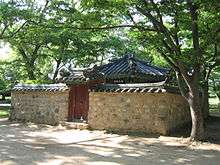Gyerim
| Gyerim | |
 | |
| Korean name | |
|---|---|
| Hangul | 계림 |
| Hanja | 鷄林 |
| Revised Romanization | Gyerim |
| McCune–Reischauer | Kyerim |
The Gyerim is a small woodland in Gyeongju National Park, Gyeongju, South Korea. The name literally means "rooster forest." The grove lies near the old site of the Silla kingdom palace in central Gyeongju. Nearby landmarks include the Banwolseong fortress, Cheomseongdae, the Gyeongju National Museum, and the Royal Tombs Complex.[1]
History
The original name of Gyerim was Sirim (시림, 始林). However, according to the Samguk Sagi, a 12th-century Korean history, Sirim was the site where the child Kim Alji, founder of the Gyeongju Kim clan, was discovered. Found in a golden box accompanied by a rooster, he was adopted by the royal family. His descendants became the later kings of Silla and the forest where he was found was renamed Gyerim, "Rooster Forest." [2] The Samgungnyusa, a 13th-century miscellanea of tales relating to the Three Kingdoms of Korea, gives a different origin of the term Gyerim. According to that text, the founder of Silla, Hyeokgeose, was born at a stream called Gyejeong (계정, 鷄井), "rooster well," and that his future consort was born from a dragon that came to earth at another place called Gyeryongseo (계룡서, 鷄龍瑞), and for this reason the area was renamed Gyerim.[1][3]
Based upon the legends of Silla's founding, Gyerim also became a sobriquet for that state. The earliest recorded reference we have of Gyerim being used to designate Silla is from the Chinese histories. The Old Book of Tang records that in 663 Emperor Gaozong of Tang designated Silla the "Gyerim Territory Area Command" (hanja: 鷄林州都督府 ) and Munmu of Silla as its commander-in-chief.[1][4] The early eighth-century Sillan scholar Kim Dae-mun authored a no longer extant book of tales of Silla entitled Gyerim japjeon (hanja: 鷄林雜傳 ).[5]
Gyerim also appears in the title of the early twelfth-century Chinese work Jīlín Lèishì (hanja: 鷄林類事 ), which provides one of the earliest sources of information on the pronunciation of the native Korean language.[6]
Historical landmark
Being considered a holy place, a monument commemorating the birth legend of Kim Alji was built in 1803 by the Joseon.[7] Gyerim has been designated as historical landmark #19 from the Korean government since January, 1963. The grounds cover 7,300㎡ and has a dense forest of old oak, ash, zelkova, willow, Japanese clovers, scarlet maple and Japanese pagoda trees.[1][3]
Gallery
 Painting depicting the discovery of Kim Alji
Painting depicting the discovery of Kim Alji- Gyerim forest
 Gyerim Forest Monument
Gyerim Forest Monument
See also
References
- 1 2 3 4 (Korean) Gyeongju Gyerim at Doosan Encyclopedia
- ↑ (Korean) Kim Alji at Doosan Encyclopedia
- 1 2 (Korean) Gyerim at Britannica Korea
- ↑ (Korean) Gyerim dodok at Doosan Encyclopedia
- ↑ (Korean) Gyerim japjeon at Doosan Encyclopedia
- ↑ (Korean) Gyerim Yusa at Doosan Encyclopedia
- ↑ Gyeongju Gyerim Cultural Heritage Administration of Korea
| Wikimedia Commons has media related to Gyerim. |
External links
- Gyeongju National Park introduction Korea National Park Service
Coordinates: 35°52′03″N 129°13′23″E / 35.8675°N 129.2230°E